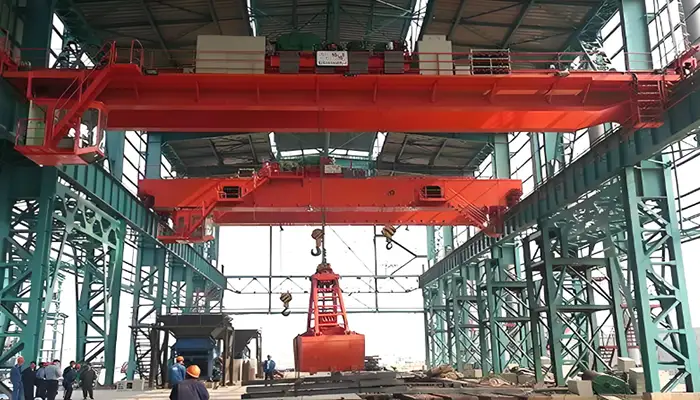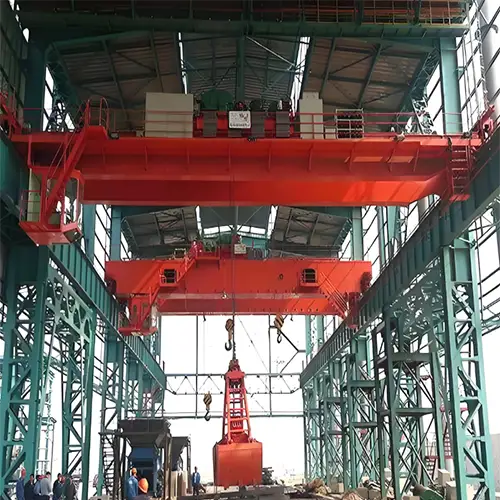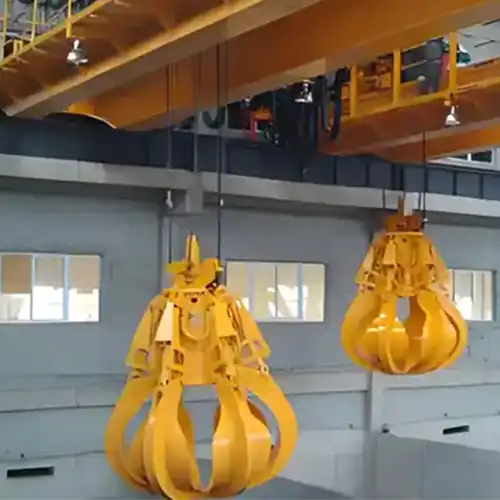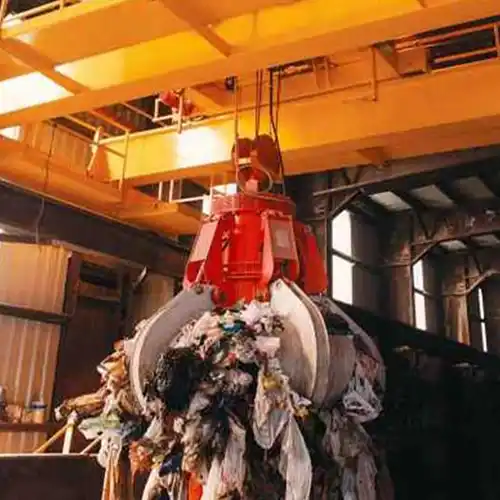Buying Guide for Clamshell Grab Cranes in Process Steam Plants
Overhead crane buying guide for selecting clamshell grab cranes, focusing on efficiency, safety, and operational needs in process steam plants.Click!
Category: Grab Crane
Your Trusted Overhead Clamshell Crane Manufacturer & Supplier
Buying Guide for Clamshell Grab Cranes in Process Steam Plants
Overhead crane buying guide for selecting clamshell grab cranes, focusing on efficiency, safety, and operational needs in process steam plants.Click!
Buying Guide for Clamshell Grab Cranes in Process Steam Plants
Clamshell grab cranes play a crucial role in the efficient operation of process steam plants. These cranes are designed to handle a variety of materials, including bulk solids and waste products, making them indispensable for maintaining productivity and safety. In process steam plants, where materials must be moved quickly and accurately, clamshell grabs provide a reliable solution for loading and unloading operations. Their ability to securely grasp and transport heavy loads minimizes the risk of spills and accidents, which is vital in high-stakes environments. Furthermore, these cranes enhance workflow by reducing manual handling, leading to improved operational efficiency and reduced labor costs.
This buying guide aims to assist facility managers, engineers, and procurement specialists in making informed decisions when purchasing clamshell grab cranes for process steam plants. With a variety of options available on the market, choosing the right crane can be overwhelming. This guide will break down the key factors to consider, from understanding different types and features to evaluating suppliers and costs. By providing detailed insights and practical advice, we aim to empower you to select a clamshell grab crane that meets your specific needs, ensuring safe and efficient operations in your steam plant.
Overview of Clamshell Grab Cranes
Clamshell grab cranes are specialized lifting devices equipped with a two-part clamshell mechanism that opens and closes to grasp materials. They are primarily used for handling loose bulk materials, such as coal, gravel, and waste products in process steam plants. The crane's design allows for precise control over the material being moved, making it ideal for both loading and unloading applications. The clamshell grab opens to scoop up materials and then closes to securely hold the load, allowing for safe transport to the desired location.

Key Components and Mechanisms
A clamshell grab crane consists of several essential components:
- Grab Bucket: The clamshell's bucket, typically made from durable materials, is designed to withstand heavy loads and harsh environments.
- Operating Mechanism: This includes hydraulic or electric systems that control the opening and closing of the grab. The choice of mechanism affects speed and efficiency.
- Support Structure: The crane's frame or gantry provides stability and strength, allowing it to lift substantial loads safely.
- Controls: User-friendly control systems enable operators to maneuver the crane with precision, ensuring effective handling of materials.
Advantages of Using Clamshell Grabs
Clamshell grab cranes offer several key advantages:
- Versatility: They can handle a wide range of materials, from bulk solids to industrial waste, making them suitable for various applications within steam plants.
- Enhanced Safety: The secure grasp of materials reduces the risk of spills and accidents, contributing to a safer work environment.
- Increased Efficiency: Clamshell grabs streamline material handling processes, significantly improving productivity by minimizing downtime and labor costs.
- Reduced Wear and Tear: Their robust construction is designed for durability, leading to lower maintenance costs and longer service life.
Overall, clamshell grab cranes are invaluable for optimizing operations in process steam plants, ensuring effective material management and operational efficiency.
Applications of Clamshell Grab Cranes in Processing Steam Plants
Clamshell grab cranes are indeed utilized in process steam plants, particularly for handling bulk materials and waste products. Here's an overview of their typical applications, workshop environments, and specific design considerations:
Typical Workshops in Process Steam Plants: Coal Handling Workshops
Typical Crane Design
In coal handling workshops, both electric and hydraulic clamshell grab cranes are commonly utilized. The choice between single and double girder designs depends on the specific requirements of the facility:
- Single Girder Cranes: These cranes are typically more compact and cost-effective, suitable for lower lifting capacities and smaller spaces. They are often used in applications where headroom is limited and handling lighter loads is sufficient.
- Double Girder Cranes: These cranes provide enhanced stability and higher load capacities. They are ideal for heavy-duty applications and can accommodate larger grab buckets for bulk coal and biomass handling.
Typical Loads
The primary materials handled in coal handling workshops include:
- Coal: This is the main fuel source in many process steam plants, requiring efficient loading and unloading.
- Biomass: Increasingly used as a renewable energy source, biomass needs similar handling capabilities to coal.
Typical Load Weights
Load weights in coal handling workshops generally range from:
- 1 ton to 20 tons: The specific weight depends on factors such as the density of the coal, moisture content, and the crane's lifting capacity. For instance, typical operations may involve moving smaller batches of coal or biomass, while larger bulk deliveries may require handling capacities closer to the upper limit.
Special Features
Clamshell grab cranes in these workshops often include:
- Heavy-Duty Grab Buckets: Designed specifically for secure handling of abrasive materials, these buckets are reinforced to withstand wear and tear from coal and biomass.
- Corrosion-Resistant Components: Given the exposure to moisture and varying environmental conditions, cranes are often constructed with materials that resist corrosion. This includes galvanized steel or specially coated components to enhance durability.
Special Considerations
In coal handling workshops, several important considerations must be addressed:
- Dust Control: Coal dust can pose significant health and environmental risks. The crane system should include effective dust suppression methods, such as water sprays or dust collectors, to minimize airborne particles during operation.
- Operational Efficiency: The crane should be designed for rapid and efficient operation to handle the high volume of coal and biomass effectively. This may involve optimizing lifting speeds and ensuring smooth transitions between lifting and lowering operations.
- Safety Features: Given the potential hazards associated with coal handling, cranes must be equipped with robust safety features, including emergency stop mechanisms, overload protection, and operational training for personnel to handle equipment safely in dusty and potentially hazardous conditions.
- Maintenance Access: Design considerations should also ensure that cranes are easy to access for routine maintenance and inspections, which are critical to maintaining operational reliability and safety in a demanding environment.
By addressing these aspects, coal handling workshops can optimize their operations, ensuring effective and safe material management while adhering to environmental standards and improving overall efficiency.
Typical Workshops in Process Steam Plants: Ash Handling Workshops
Typical Crane Design
In ash handling workshops, hydraulic clamshell grab cranes are predominantly used due to their ability to handle heavier and more demanding loads effectively. These cranes feature robust designs that ensure durability and stability, essential for managing the challenges associated with ash materials.
Typical Loads
The primary materials managed in ash handling workshops include:
- Fly Ash: A byproduct of coal combustion, fly ash is lightweight and can create dust when handled.
- Bottom Ash: This coarser residue settles at the bottom of the combustion chamber and requires different handling techniques due to its heavier weight.
- Other Waste Materials: Various other residual materials from the combustion process may also be handled, necessitating versatile crane capabilities.
Typical Load Weights
Load weights in ash handling workshops typically range from:
- 5 tons to 30 tons: The specific weight depends on the material type and the operational requirements. Fly ash is generally lighter, while bottom ash tends to be heavier, requiring cranes capable of lifting up to 30 tons in some scenarios.
Special Features
Clamshell grab cranes in ash handling applications often incorporate:
- Sealed Grab Buckets: These are designed to minimize spillage and prevent the release of dust into the environment, enhancing safety and cleanliness during operations.
- Specialized Coatings: To combat the corrosive effects of ash and the high humidity often present in handling environments, cranes are equipped with coatings that provide enhanced corrosion resistance, extending the life of the equipment.
Special Considerations
Several critical factors must be taken into account in ash handling workshops:
- Maintenance Access: Ensuring that the crane design allows for easy access for maintenance and inspection is crucial. Regular maintenance helps prevent breakdowns and maintains operational efficiency, especially given the harsh conditions associated with ash handling.
- Dust Control: The fine particulate nature of fly ash poses significant health risks and environmental challenges. Implementing effective dust control measures, such as dust suppression systems and proper ventilation, is essential to protect workers and minimize airborne pollutants.
- Operational Safety: Given the potential hazards associated with ash, cranes must be fitted with advanced safety features, including emergency shut-off systems and overload protection mechanisms. Operator training is critical to ensure safe handling practices in potentially hazardous environments.
By addressing these design and operational considerations, ash handling workshops can optimize their efficiency while ensuring safety and compliance with environmental regulations. This careful approach contributes to the effective management of ash and enhances the overall performance of the process steam plant.
Chemical Handling Workshops
Typical Crane Design
In chemical handling workshops, electric cranes are the preferred choice due to their efficiency and precision. These cranes are often equipped with specialized grabs designed specifically for handling various forms of chemicals, ensuring safe and effective material movement. The electric design allows for smooth operation and better control, minimizing the risk of spills or accidents.
Typical Loads
Crane operations in these environments typically involve handling liquid chemicals, solid chemical compounds, and bulk materials. The versatility of specialized grabs allows for the efficient transfer of both viscous liquids and granular solids, catering to the diverse needs of chemical processing and storage.
Typical Load Weights
The load weights for cranes in chemical handling workshops generally range from 1 ton to 15 tons. This capacity allows for the handling of substantial quantities of chemicals while maintaining operational safety. Cranes are often designed to accommodate varying load sizes, depending on specific workshop requirements.
Special Features
To enhance safety and efficiency, cranes used in chemical handling workshops come with several critical features:
- Explosion-proof Construction: Designed to prevent ignition in potentially explosive environments.
- Chemical-Resistant Materials: Utilizing materials that withstand corrosive effects of chemicals, extending the crane's lifespan.
- Safety Interlocks: Prevent unauthorized or unsafe operations by ensuring the crane operates only under safe conditions.
- Emergency Shut-Off Systems: Quick-access systems that halt crane operations in case of an emergency, protecting personnel and equipment.
Special Considerations
Compliance with safety regulations is paramount in chemical handling environments. Cranes must meet industry standards to prevent hazardous incidents. Additionally, thorough training for operators is essential, ensuring they are equipped with the knowledge and skills to operate the cranes safely and effectively. Regular inspections and maintenance of cranes are also vital to ensure they remain in optimal working condition, minimizing risks associated with chemical handling.
Maintenance and Repair Workshops
Typical Crane Design
In maintenance and repair workshops, versatile cranes are essential for efficiently handling a wide range of materials and components. These cranes are often designed with adjustable configurations, allowing them to adapt to various tasks. Whether lifting equipment parts, tools, or machinery components, these cranes ensure that workshop operations run smoothly and efficiently.
Typical Loads
The loads managed in maintenance and repair workshops typically include equipment parts, tools, and various machinery components. This diversity necessitates a crane design that can accommodate different shapes, sizes, and weights, ensuring that each item can be lifted safely and securely. The ability to handle both small tools and larger machinery parts makes these cranes invaluable in a workshop setting.
Typical Load Weights
Load weights in these workshops usually range from 1 ton to 10 tons, depending on the specific item being lifted. This capacity provides flexibility in operations, allowing the crane to handle everything from lightweight components to heavier machinery parts without compromising safety or performance.
Special Features
Crane designs in maintenance and repair workshops incorporate several special features to enhance functionality:
- Flexible Reach and Maneuverability: These cranes are designed to reach into tight spaces and maneuver around obstacles, allowing for effective handling in various workshop configurations.
- Lightweight Design: A lighter crane structure facilitates easier operation and reduces the physical strain on operators. This design consideration enhances mobility and ensures that cranes can be repositioned with minimal effort.
Special Considerations
In maintenance and repair environments, prioritizing ease of access for maintenance and inspection of the crane itself is crucial. Regular checks and maintenance are essential to ensure that cranes operate safely and efficiently. This includes easy access to control panels, wiring, and mechanical components for routine inspections and repairs. Workshops should be designed with ample space around cranes to allow for quick and safe maintenance, reducing downtime and ensuring that operations remain uninterrupted. Additionally, operators should be trained in basic maintenance procedures to enhance overall safety and efficiency within the workshop.
Summary of Considerations for Each Workshop
- Load Handling: Each workshop has unique load requirements based on the materials being handled, influencing crane design and specifications.
- Safety Features: All cranes should include safety features like emergency stop mechanisms and overload protection tailored to specific workshop hazards.
- Durability and Maintenance: Given the harsh environments of steam plants, cranes should be designed for durability and ease of maintenance, including accessibility for inspections and repairs.
- Operator Training: Specialized training for operators is critical to ensure safe and efficient use, especially in workshops handling hazardous materials.
Overall, the selection of clamshell grab cranes for process steam plants requires careful consideration of the specific workshop needs, load handling capabilities, and environmental conditions to ensure optimal performance and safety.
Assessing Your Needs
Identifying Specific Applications in Process Steam Plants
When selecting a clamshell grab crane, it's essential to identify its specific applications within your process steam plant. Common uses include loading and unloading bulk materials like coal, biomass, or chemicals, as well as handling byproducts and waste. Consider the environments in which the crane will operate, such as storage areas, processing units, or loading docks. Understanding the unique requirements of these applications will help ensure the chosen crane effectively meets operational demands.
Load Capacity Requirements
Load capacity is a critical factor when assessing your needs. Clamshell grab cranes come in various sizes, each with specific lifting capacities. Evaluate the maximum weight of the materials you need to handle and choose a crane that can comfortably manage these loads. It's also wise to account for potential variations in material weight due to moisture content or bulk density. Selecting a crane with a slightly higher capacity than your maximum requirement can provide an additional safety margin and accommodate unexpected load increases.
Frequency and Volume of Use
Consider how often the crane will be used and the volume of material it needs to handle regularly. If your operations involve continuous or high-frequency lifting, a more robust and efficient model may be necessary to ensure reliability and performance. Conversely, if the crane will be used sporadically, a lighter model might suffice. Additionally, assess peak usage periods; understanding these patterns can help you determine the ideal crane features, such as faster operating speeds or advanced control systems, to optimize workflow during busy times.
Types of Clamshell Grab Cranes
Electric vs. Hydraulic Models
Clamshell grab cranes come in two primary types: electric and hydraulic. Electric models are typically easier to maintain and can be more energy-efficient, making them ideal for environments where power availability is consistent. They offer precise control for lighter loads and are often quieter in operation. In contrast, hydraulic models are known for their strength and versatility, capable of handling heavier loads and more demanding tasks. These cranes excel in environments with high operational intensity, providing powerful lifting capabilities. When choosing between the two, consider the specific material handling needs and operational conditions of your steam plant.
Single vs. Double Girder Designs
Clamshell grab cranes can also be categorized by their girder design: single or double girder. Single girder cranes are generally more compact and cost-effective, making them suitable for lower lifting capacities and smaller spaces. They are easier to install and require less headroom. Double girder cranes, on the other hand, offer greater stability and can support higher load capacities. This design is beneficial for heavier and more complex operations, providing improved lifting height and efficiency. Assessing your facility's layout and load requirements will help determine which design is the best fit.
Customization Options
Customization is an important aspect of selecting a clamshell grab crane. Many manufacturers offer options tailored to specific operational needs, such as specialized grab shapes for different materials, extended reach capabilities, or enhanced safety features like anti-collision systems. Additionally, you can choose between various control systems, including remote controls for increased operator flexibility. Discussing your unique requirements with suppliers can lead to a crane that perfectly aligns with your steam plant's operational goals, enhancing overall efficiency and safety.
Essential Features to Consider in Process Steam Plants
Safety Features
- Emergency Stop Mechanisms: Safety is key in any industrial setting. Clamshell grab cranes should be equipped with easily accessible emergency stop buttons that allow operators to halt operations immediately in case of an emergency. This feature can prevent accidents and ensure quick responses to unexpected situations.
- Overload Protection: Overloading a crane can lead to severe safety risks and equipment damage. Look for cranes that include built-in overload protection systems, which automatically stop operations if the weight exceeds the crane's capacity. This feature helps safeguard both the crane and personnel working nearby.
Material and Design Considerations
- Corrosion Resistance: Given the environments of process steam plants, which often involve exposure to moisture and harsh chemicals, selecting cranes made from corrosion-resistant materials is crucial. Look for components treated with anti-corrosion coatings or those made from stainless steel to ensure longevity and reliability.
- Durability in Harsh Environments: The design of the crane should be robust enough to withstand the demanding conditions of a steam plant, including high temperatures and abrasive materials. Features like reinforced structures and wear-resistant components will enhance the crane's durability and reduce maintenance needs over time.
Operating Speed and Efficiency
Efficiency is key in maximizing productivity. Evaluate the operating speed of the clamshell grab crane, as faster lifting and lowering can significantly enhance workflow, especially in high-demand environments. Additionally, consider features that promote energy efficiency, such as variable speed drives or energy recovery systems, which can lower operational costs while maintaining performance. Choosing a crane that balances speed with precision will ensure effective material handling and contribute to overall operational efficiency.
Evaluating Grab Crane Suppliers
Reputation and Experience
When selecting a supplier for clamshell grab cranes, it's essential to consider their reputation and industry experience. Research the supplier's history, including how long they have been in the market and their track record of delivering quality products. Look for testimonials, case studies, and references from other process steam plants to gauge customer satisfaction and the reliability of their equipment. A well-established supplier with a proven history is more likely to provide a crane that meets your needs and stands the test of time.
Customer Support and Maintenance Services
Effective customer support is crucial for the smooth operation of your clamshell grab crane. Evaluate the supplier's commitment to customer service, including their responsiveness to inquiries and support during the purchasing process. Additionally, consider whether they offer maintenance services and training for your staff. A supplier that provides comprehensive training on operation and maintenance can significantly reduce the likelihood of operational issues and prolong the crane's lifespan.
Warranty and After-Sales Support
A robust warranty is an indicator of a supplier's confidence in their product. Ensure that the crane comes with a warranty that covers both parts and labor for a reasonable period. Review the terms of the warranty carefully, paying attention to what is included and any conditions that might apply. Furthermore, inquire about the supplier's after-sales support, including their availability for repairs, parts replacement, and technical assistance. A supplier that offers strong after-sales support can make a significant difference in the long-term performance and reliability of your clamshell grab crane.
Cost Analysis
Budgeting for Initial Purchase
When budgeting for a clamshell grab crane, it's important to consider not just the purchase price, but also the costs associated with installation and any necessary modifications to your facility. Research different models and their features, as prices can vary significantly based on capacity, design, and additional functionalities. Additionally, factor in the potential costs of training your operators and maintenance staff to ensure safe and efficient operation from the outset.
Long-Term Operating Costs
Beyond the initial purchase, evaluate the long-term operating costs associated with the crane. This includes energy consumption, maintenance, and any potential repair costs over the crane's lifespan. Energy-efficient models may have higher upfront costs but can save money in the long run through reduced energy bills. Regular maintenance is vital for preventing costly breakdowns, so consider budgeting for routine inspections and part replacements as part of your overall cost planning.
Cost-Benefit Analysis
Conducting a cost-benefit analysis can help justify the investment in a clamshell grab crane. Assess the potential savings from improved efficiency, reduced labor costs, and minimized downtime. Compare these savings against the total cost of ownership, including purchase price, operating expenses, and maintenance. This analysis will provide a clearer picture of the crane's return on investment and help you make a more informed decision about whether the upfront costs align with the long-term benefits for your process steam plant.
Conclusion
In summary, selecting the right clamshell grab crane for your process steam plant involves careful consideration of several key factors. Start by identifying the specific applications and load capacities required for your operations. Assess the types of cranes available, weighing the benefits of electric versus hydraulic models and single versus double girder designs. Pay close attention to essential features such as safety mechanisms, material durability, and operational efficiency. Evaluating suppliers based on reputation, customer support, and warranty options will further ensure you make a reliable choice. Finally, conduct a thorough cost analysis to understand both initial investments and long-term operational expenses.
As you navigate the process of purchasing a clamshell grab crane, take the time to gather all necessary information and consult with industry experts. By doing so, you'll be equipped to make a well-informed decision that aligns with your plant's operational needs and goals. Investing in the right crane can significantly enhance productivity, safety, and efficiency in your process steam plant, ultimately leading to a more successful and sustainable operation.
Related Products

Latest project
150 Ton Overhead Crane Installation Feedback – Paraguay Case
QDX 150 ton overhead crane in action in Paraguay. Installation photos, video, and client feedback show performance, safety, and heavy-lifting efficiency.
Free consultation to Confirm Parameters & Specifications and Get
Latest Crane Price & Crane Rate.
- Types of overhead cranes : _______?
- Optional: Overhead travelling crane, goliath gantry crane,Slewing jib crane, Single girder or double girder crane,small portable crane or kbk crane, etc.
- Capacity of overhead crane: _______?
- Optional: 0.25ton, 0.5 ton, 1 ton, 2 ton, 3ton, 5 ton, 10 ton,15ton, 20ton, 25 ton, 30ton,35ton, up to 550ton, etc.
- Crane span & lifting height : _______?
- Crane travelling length : _____?
- Control of overhead crane:_______?
- Optional: pendant/ remote/cabin control
- Voltage supply of overhead crane:_____?
- Eg,: 380V50/60HZ,3Phase or others,etc.
- Application/usage of crane:_______?
- Eg,: Steel mill, ,injection mold, cement,stone, concrete,granite, general manufacturing, etc.
Just leave a message via the contact form and our hoist and crane engineer will contact you with in 24working hours.
Get In Touch



